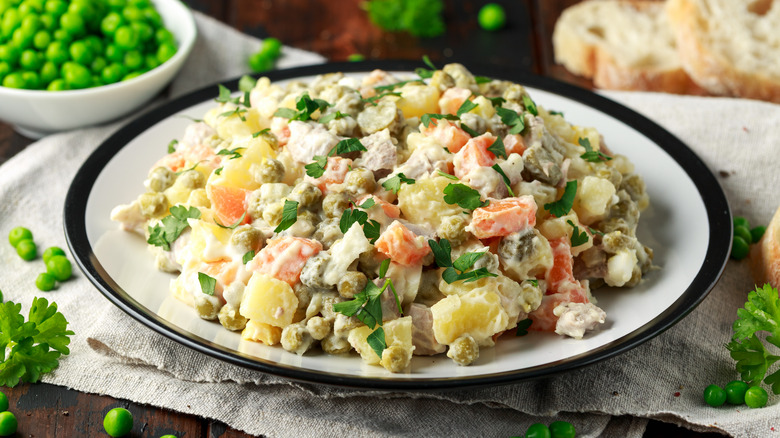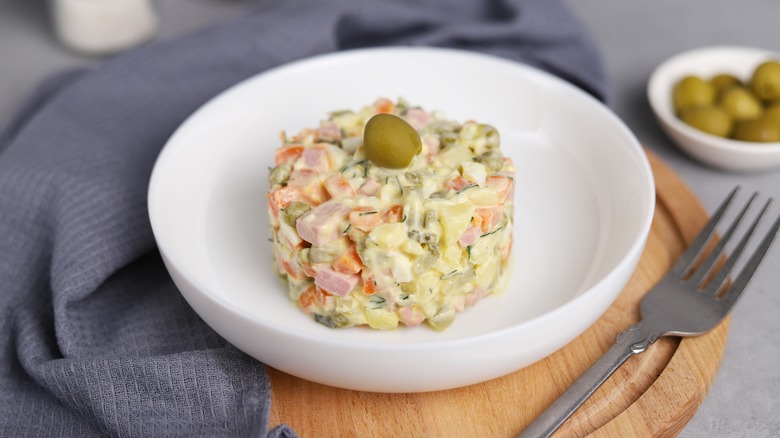What Separates Russian Potato Salad From Its American Counterpart?
Potato salad is one of those crowd-pleasing side dishes that comes in many forms. Because it is such a versatile dish, a myriad of regional versions exist, and there are so many different types to try. The Russian iteration of this starchy staple is commonly known as "Olivier Salad," and you're likely to find versions of it on tables throughout Eastern Europe. Though there are some similarities, it stands apart from American potato salad recipes with its distinct texture and distinguishing ingredients. Ham, pickles, peas, carrots, and hard-boiled eggs are finely diced and mixed together with potatoes, mayo, and fresh herbs to make this "Ruska Salata." The result is a creamy, salty, savory salad that is colorful and rich. For many Eastern European communities, this potato salad has come to be associated with winter holiday celebrations and is often served for New Year's. It's a seasonal dish that conjures memories of parties and family gatherings.
American potato salad, on the other hand, is a common side dish at barbecue joints and a staple at picnics and potlucks. It's casual dining fare that is eaten year-round, and while it can vary in ingredients, the American classic is pretty straightforward. This version contains fewer veggies than its Russian cousin and is usually limited to a bit of diced onion, celery, and pickles. It's also generally meat-free unless someone feels like getting fancy with the bacon bits. American potato salad is usually chunkier than the more delicate Olivier.
Lucien Oliver, creator of Russia's Oliver Salad
The man for which the salad is named, Lucien Olivier created his eponymous salad in the 1860's. Oliver worked as a chef in the French restaurant, L'Hermitage — one of the first upscale restaurants in Moscow. Oliver Salad was so popular among guests that it soon became the restaurant's signature dish. Lucien Olivier was trained in French cooking and crafted his own brand of cultural fusion cuisine, importing some ingredients from France, Switzerland, and elsewhere, but honoring traditional Russian recipes as well. He created the salad with seasonal ingredients available in Moscow but made the mayonnaise with French vinegar for a bit of worldly flair.
The version of the salad that is popular today is likely quite a bit different from Olivier's popular potato salad. It's thought that the original included caviar, capers, crayfish, beef tongue, and some kind of fowl like smoked duck or grouse. Ham has become the most popular meat in this dish, but based on personal preferences or family recipes, some people opt to substitute sausage, salami, bologna, or chicken. Sometimes it is served as a type of seafood salad, with salmon or tuna mixed in to add some salty protein.
The German roots of an American favorite
American potato salad has some European roots as well. German immigrants brought recipes and some traditional foods when they came to the States in the 19th century. Because of the large number of German immigrants in the southern states, and the generally warm relationship between the two communities, German potato salad recipes were adopted and adapted by enslaved peoples in those areas. The dish became a favorite for many black southern families, becoming intrinsically tied to barbecue, another Southern culinary tradition that dates back centuries. Most ready-made potato salad that you find at the deli counter today is more mayo-heavy than these early iterations would have been, as they relied on vinegar, sugar, and herbs to dress the potatoes.
Both the Russian and American version of this popular salad have spread and evolved over the years, as recipes do when they are shared among friends and passed down through generations. The Slavic specialty has become popular in many parts of the world, such as Bulgaria, where it is commonly eaten with fresh baked bread. In Spain, it is a refreshing addition to tapas menus, often called Ensaladilla Rusa. Similarly, countless versions of American potato salad have been cooked up across the country, like the spicy Texas potato salad, and the famously creamy Amish potato salad. This dish is one of those culinary curiosities that comes in many shapes and styles, and there is often a story to learn behind every recipe.



